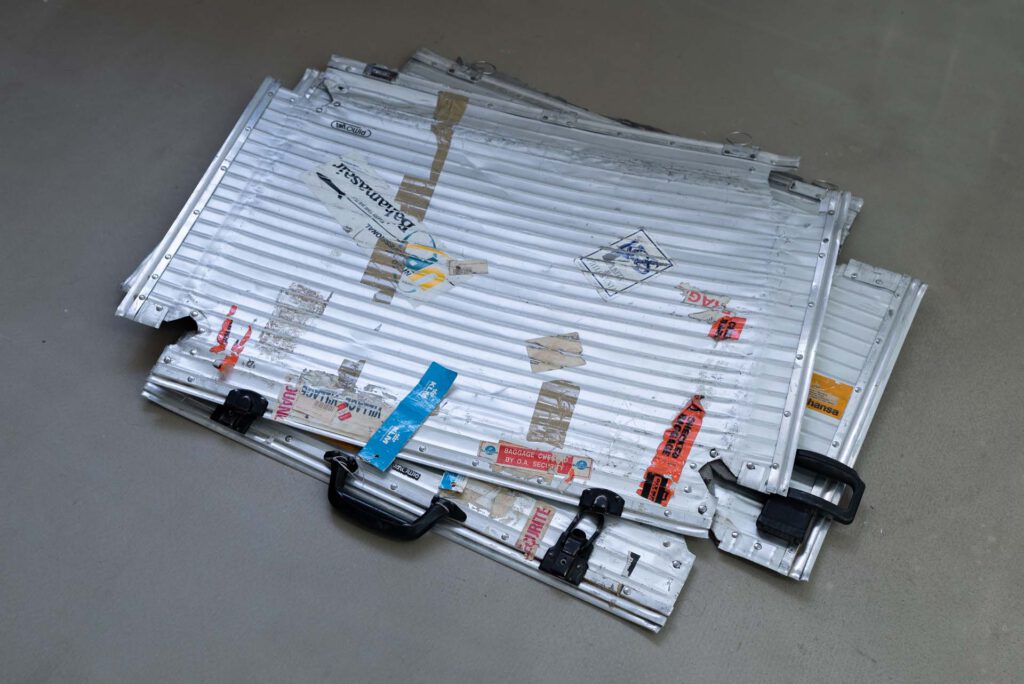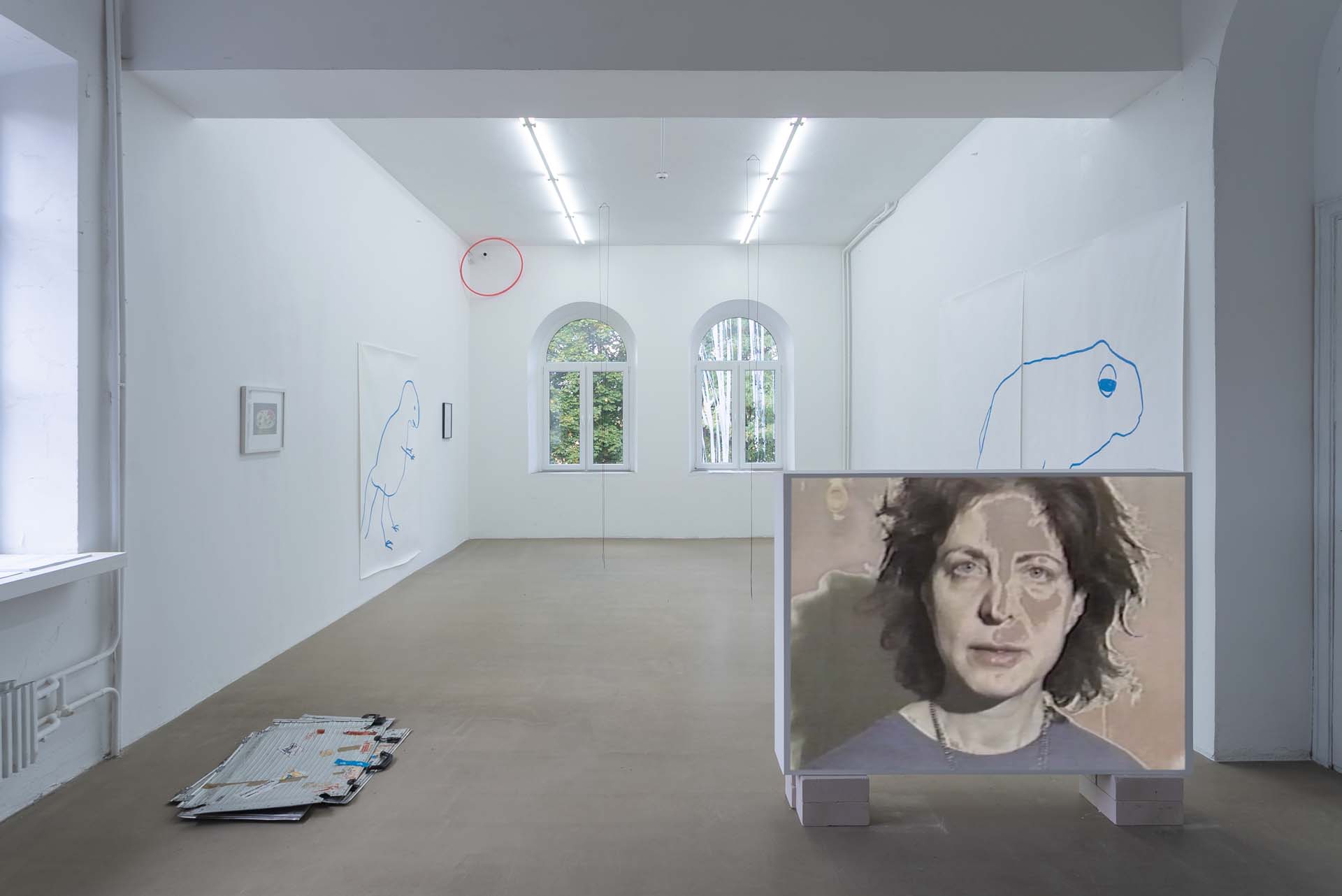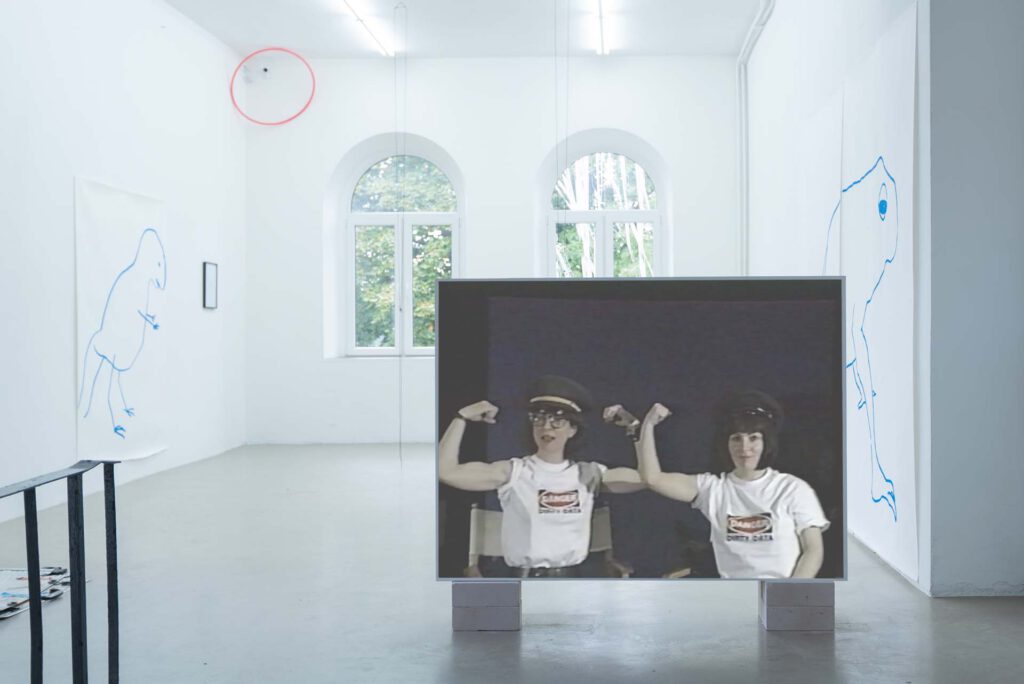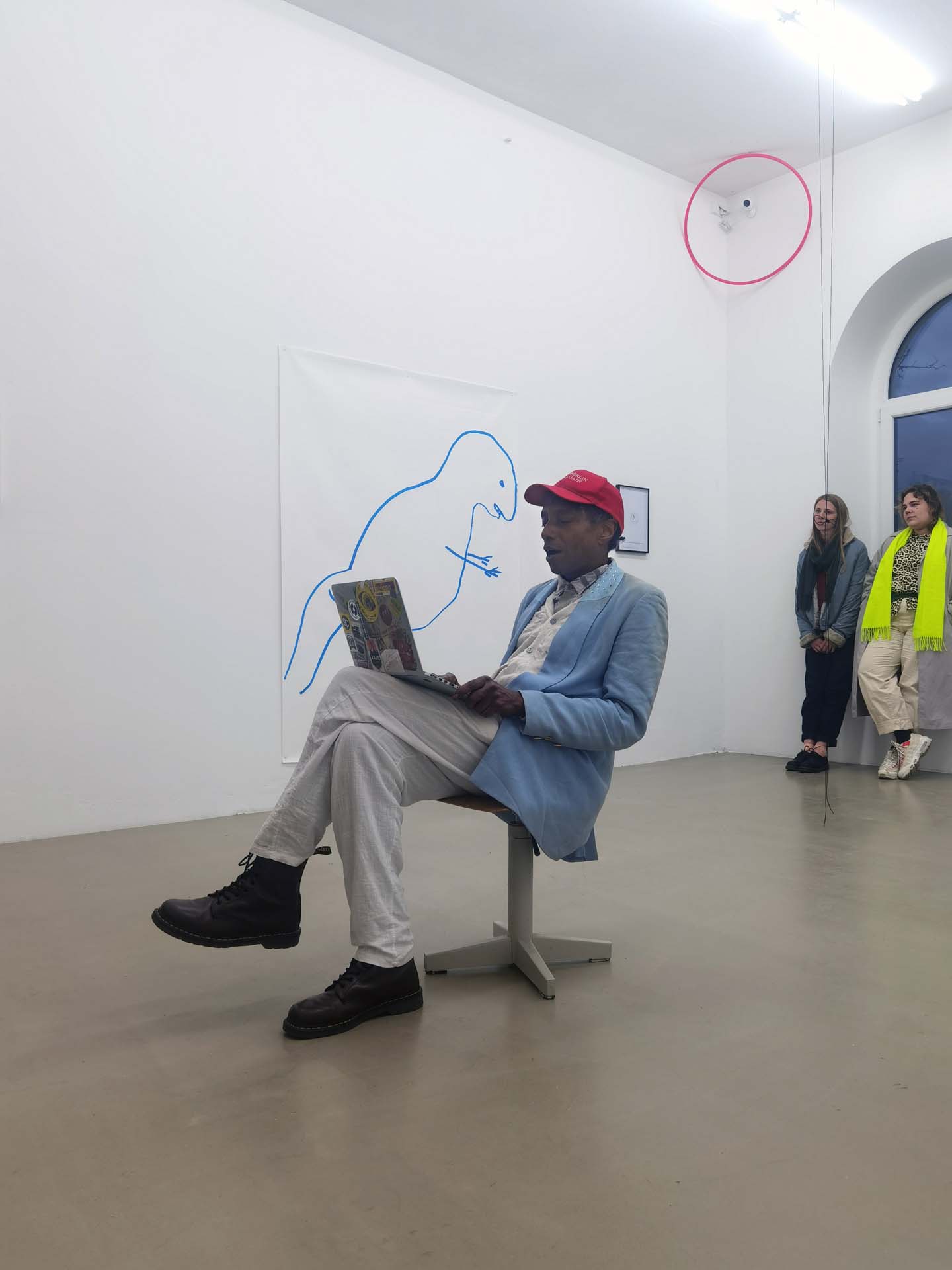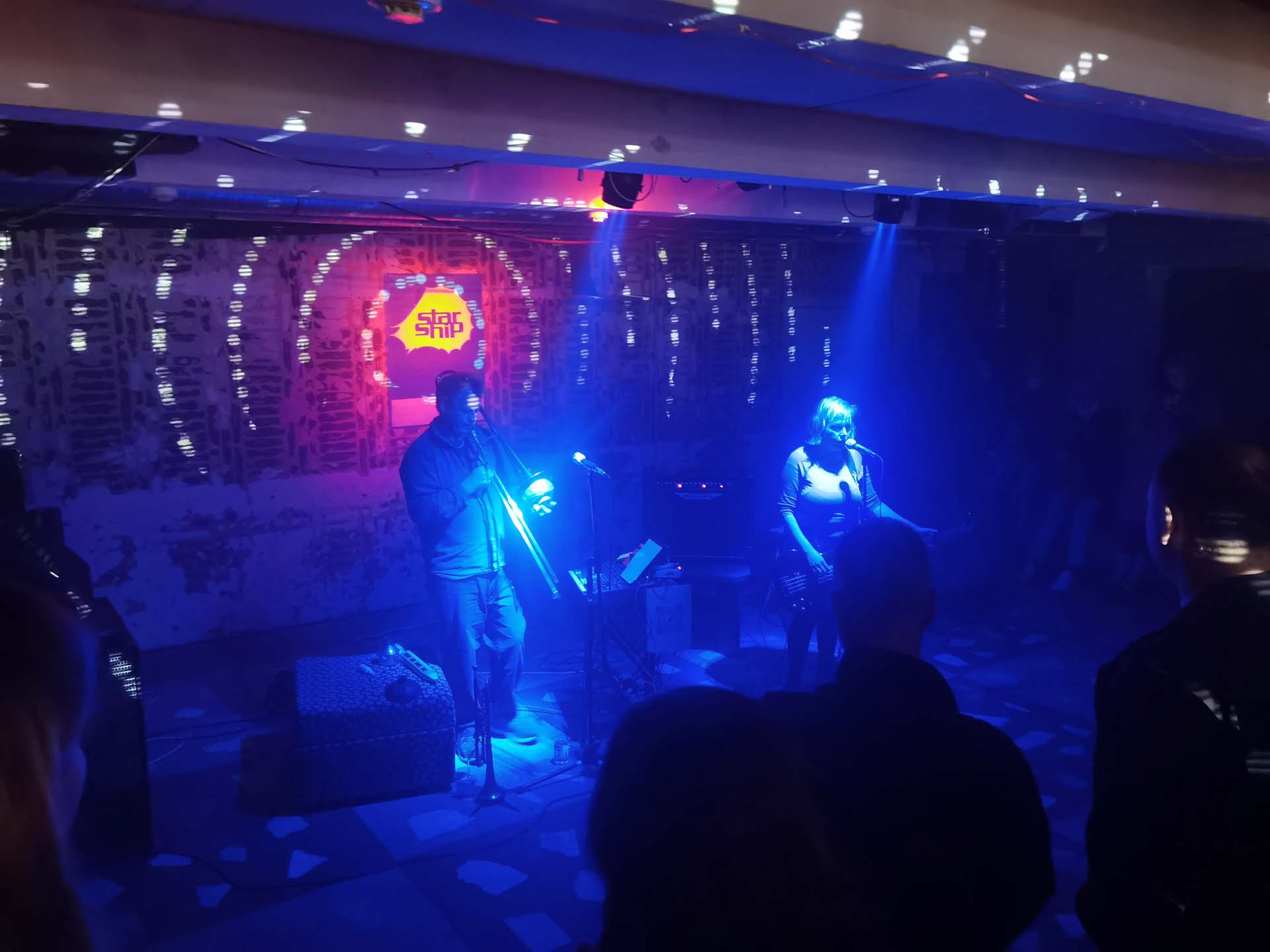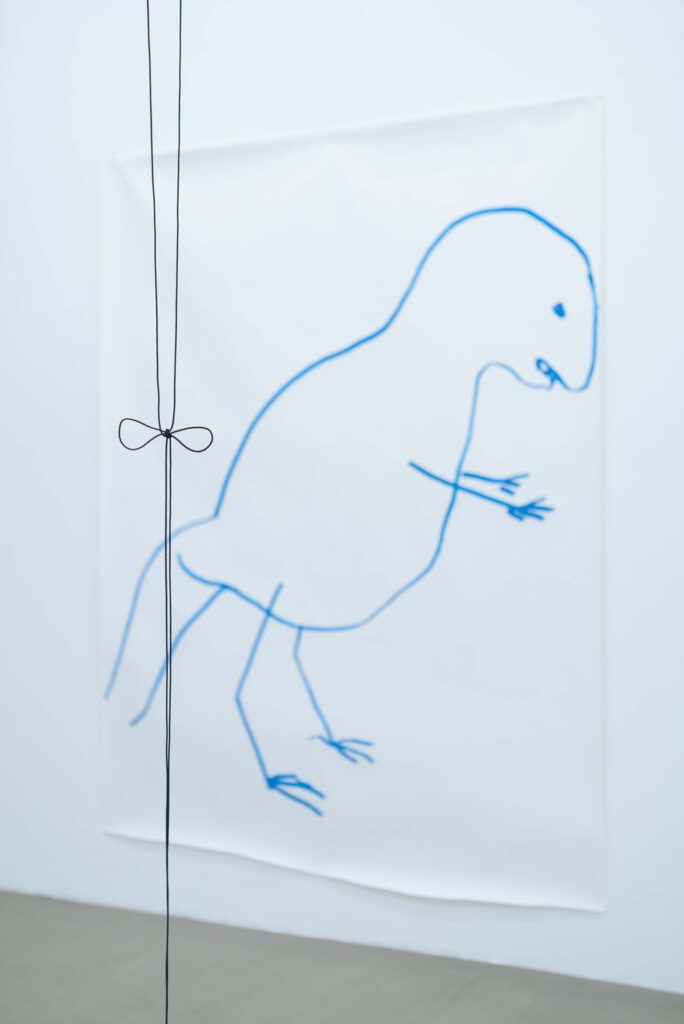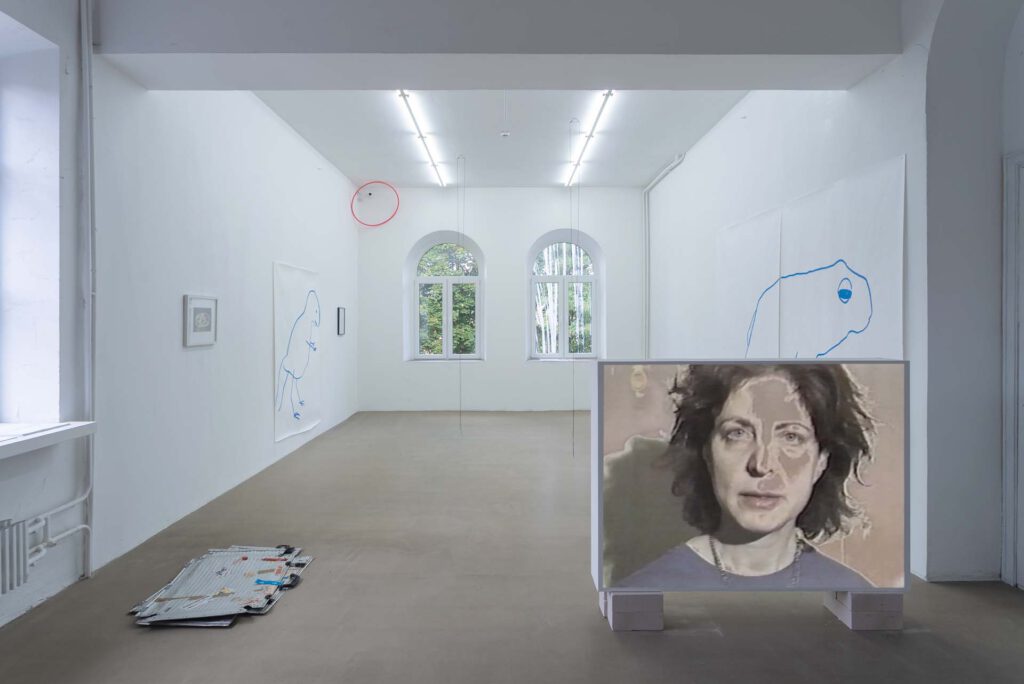
The Weather in Fred
Sandback
Eric D. Clark, Michèle Graf & Selina Grüter, Laura Kaminskaitė,
Sebastian Luetgert, Robertas Narkus, Eleni Poulou & Hilary Jeffery,
Ulla Rossek, Julia Scher, Valerie Stahl von Stromberg, Hannah Weinberger, Ariane Müller, Martin Ebner
curated by Ariane Müller, Audrius Pocius, and Martin Ebner
Opening: September 16, 2022
Exhibition: 17.9.2022 – 22.10.2022
all photos, except outside and performances:
© Laurynas Skeisgiela
The beings in the universe are filled, in turn, like human barometers, with the stuff of the universe. This is as true for art as it is for the irreducibly complex systems and substances that constitute the weather.
Eve Kosofsky Sedgwick: The Weather in Proust
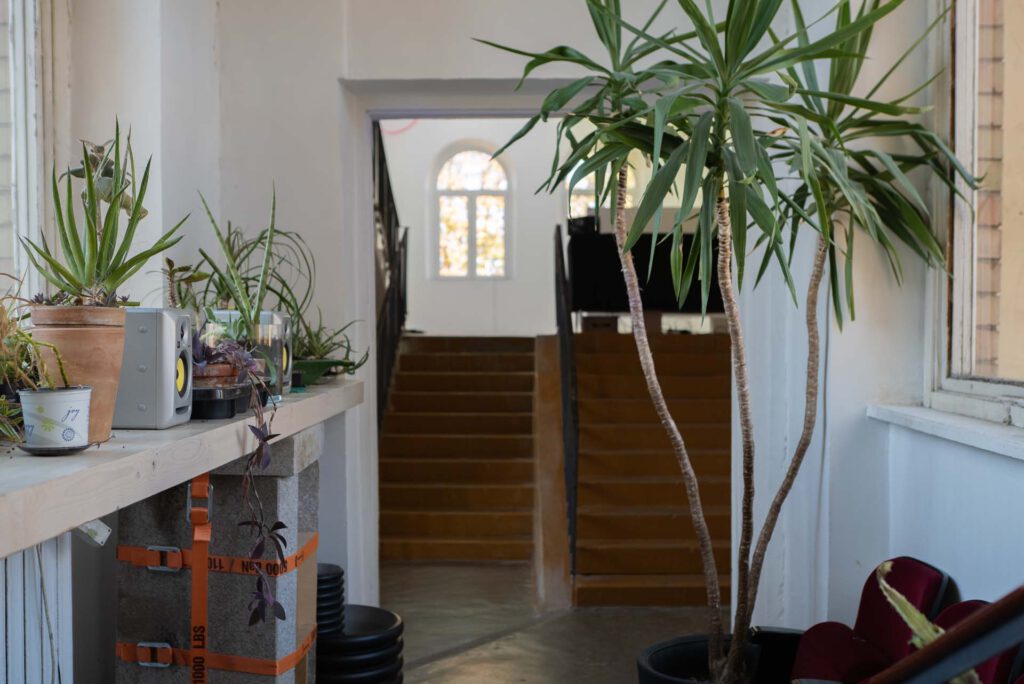
Hannah Weinberger, Sounds Like Us, 2022
2 channel audio installation, 10 min, (excerpt)

Michèle Graf & Selina Grüter, Pedestrian, 2022
Riso print poster
Michèle Graf & Selina Grueter, Pedestrian, 2018/2022,
performed by Hanna Ijas and Saulė Noreikaitė

Ariane Müller: Madame George, wall text, 2022
Sebastian Luetgert, Unprompted #106, video, silent, 2022
Sebastian Luetgert, Unprompted #106, 2022
Video, silent, 2 min.
Martin Ebner, Rain, 2008/2022, Video, 1.30 min.
Julia Scher, MTV Pilot, video, 45’10“, 1996
(via: juliascher.com)
Organza Ray – Eleni Poulou & Hilary Jeffery
concert performance, Sept 16, 2022 (excerpt)

Martin Ebner, 11:11, facade curtain installation
2022, view from inside
Martin Ebner, 11:11, facade curtain installation
2022, view from outside
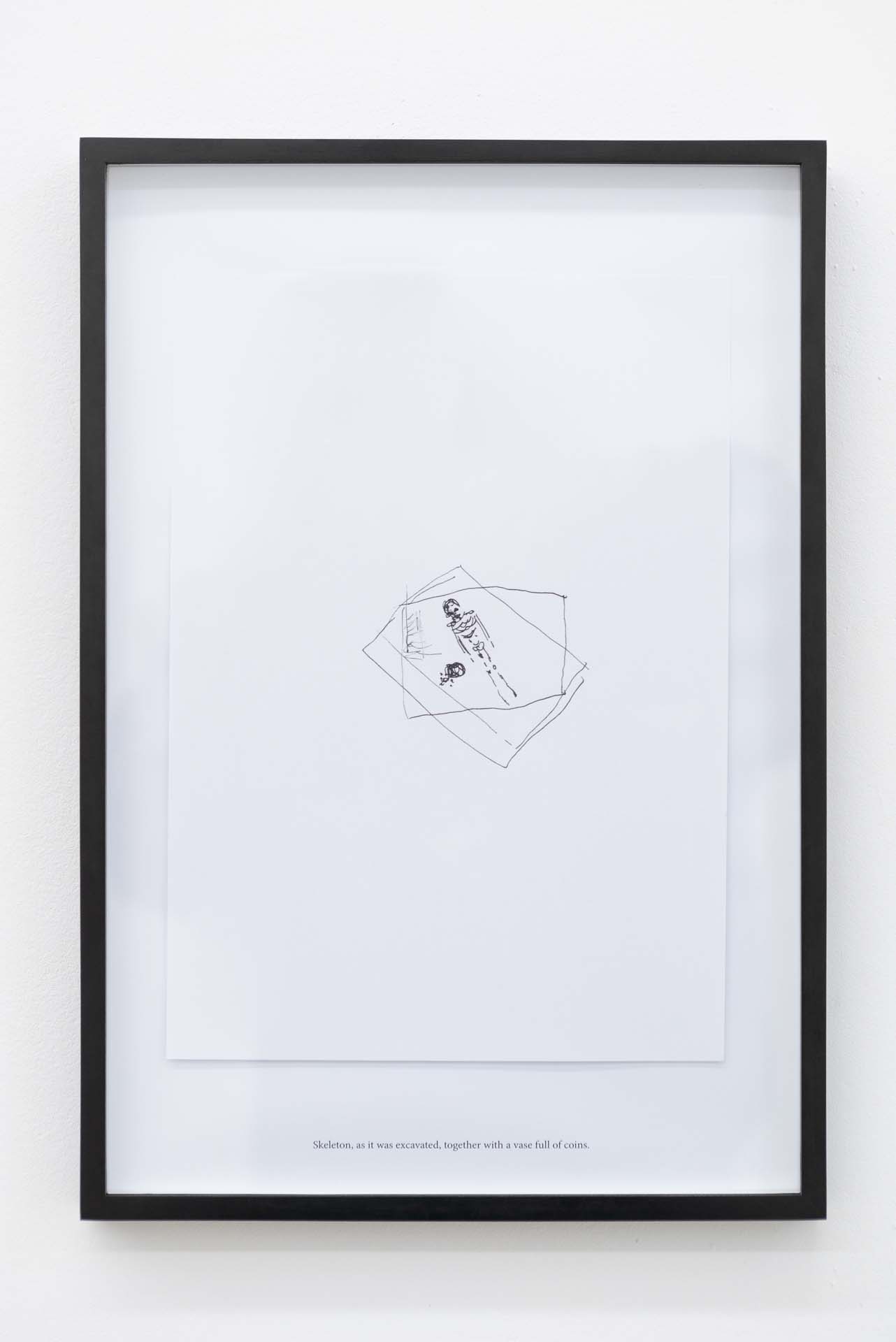
Ulla Rossek, Skeleton as it was excavated,
together with a vase full of coins
drawing, framed, 32x42cm, 2020
The Weather in Fred Sandback
Ariane Müller, September 2022
Contents:
FENDE PRITING IS VERY QUIER 14 1HISTAPBORS TO READ BY 36 STIC VION
This exhibition has started slowly with us thinking about Andrea Fraser’s text: Why Does Fred Sandback’s work make me cry?
We took this title sentence/remark as the main message of her essay, even when it was only the title, replacing Andrea Fraser’s me for our us, and questioned our sentiments. So why are we affected or deeply touched by a work, that is so minimal, and thus so impersonal, not hinting at an author but relational between the spectator and the artist, and so non-textual? In our reflection the answer was: Because one as a spectator is so touched or liberated by the own possibility to see. One is affected/delighted or wondered by one’s senses, comparable to the sentiment expressed in the image of the deaf person who thanks to electronic means hears something for the first time—pure delight.
Andrea Fraser links her emotions to the psychoanalyst moment of object loss (and the remembrance of object loss)—a notion we again took literally (and also with a vivid image of the empty spaces of Fred Sandback’s exhibitions—devoid of objects, citing them merely). We didn’t go deeper into the significance object loss has as the Freudian term of excessive desperation of feeling lost, because the main object that links one to the world is not there—But in the simple meaning: Object loss—the world has lost its objects—a world with no things. Seeing the object not as the signified, and not as target, but in the definition of objects as material parts of the world, produced to be in the world as objects (Gegenstand = literally: which stands against us).
And we followed Italian philosopher Emanuele Coccia’s thoughts in „Il bene delle cose“ The good of the things—A world without things is a world without morals, without ethics.
Emanuele Coccia argues that things, goods, come with ethics, with a moral about what is good (!) or bad. Their advertisement shows us how the world should be handled, how it should be used, providing us with an ethics of everyday life.
This can be seen, following Coccia, as a positive move, since it re-grounds ethics to materialism, decisions made on tangible grounds, replacing non-materialistic, idealistic sources of morals and ethics (religion, a higher meaning). This ethics and morals that comes with things in the end shows us that we live in a deeply secular society.
So, we wished the exhibition to be a space without things—thus with no ethics—with no morals. In the definition of ethics: the way the world is handled, or morals, the way the world is thought. A space devoid of these rulers and guides.
Fred Sandback says (in an interview) his work is about the real space (even when he is only doing his works in interior spaces), he calls it pedestrian space because it comes on the foot level (is not exhibited or mediatized). We later learned from Michèle Graf and Selina Grueter that pedestrian also means dull (but this hints again to a moral of things, and the good in the good, the car).
Our thinking turned to the real (as in real space). If we here follow Lacan’s definition of the real as the part of our perception that is independent from our endeavors to grasp the real, it would be something resisting symbolization, and consequently it would be not-verbalizable, hence not-remember-able. And Freud said to the topic of the not-remember-able that it has to be repeated, and will be repeated (= is haunting us, because we can not grasp it, symbolize it by words or images, verbalize it).
Which also means the real is fleeting, since we immediately try to symbolize whatever appears, whatever we sense. The real is a resistor to this effort. It is beyond sense and nonsense, while being solely linked to the senses.
Basically we come here to the effects of Fred Sandback’s work again. It can be seen as the connection to the real in an illusionistic space—even when he says rightfully what he creates is not illusionistic in itself. It triggers our possibilities to be illusionistic but remains calm vis-a-vis the effort.
So how to make an exhibition out of this.
We are interested in work that is somehow beyond the space as a spatial category. It does not place itself into the space it moves somehow parallel. Maybe this can be called hauntology, a research on ghostly spaces, where we get in touch with the real without having the possibility to tell them—haunting as in returning, and in necessarily perfromed again, and again, and again.
These ghostly space can be seen in the haunting parallelism of real space in its supervised counterpart, doubling, mirroring, within the surveillance camera. We saw it in Julia Scher’s absolutely hilarious attempt to fill it up again with people (this non space). We saw it in a hint towards a space, like in „Pedestrian“ the performance by Selina Grueter and Michèle Graf, where a space is only created by movements meant as well to communicate as to assign. It is about customs (regulations regarding the space between people.)
But at the same time the exhibition is also simple. We think that albeit efforts to privatise and rob, there is still so much space, and one has to hint to it. The unspeakable space of the real, uncanny because we cannot verbalize it, when we encounter it, and when we have found words for it it is gone, is the main meeting place for artists. (It is basically everything, the whole world, but alas so difficult to encounter once symbolization and again the imaginary, seen as a sort of Über-Ich or morals, steps into place, this shady fleeting space of the encounters with the real is where art dwells.)
Insert Rationale: Object loss:
Basically the object is the thing (symbolised outside entity) that is necessary for self constitution because it reacts, and helps us to self constitute.
Her object—the thing that stands against us.
Whatever got lost.
I think there is something interesting in the specific video work of Julia Scher, or even more so in the whole work, to make something visible, which is not there. Namely surveillance, and there to condition people, and to subject them to behave under the conditions of consumption and capitalism.
Something is described that is not obvious to everyone.
What we see is a change in behavior patterns and moments of identification with symbolic things and ethics. This is a state of change. Society changes, which means the relation to things is discussed anew.
de-identification
data anonymity
The lost object is not the reason for mourning and feeling abandoned, but maybe a step into a dis-identification with the promises that we connect to things. It’s maybe connected to a Berlin specific feeling that there was not much to be gained by contributing to a public sphere of the city, and that it had – in the meantime – worked on its realisation in things (buildings, streets, holiday houses and government buildings, representational spaces), seemingly unadvised by a usage of the city, that had taken place.
Chapter 2, George Maciunas
Negociando la colectividad, negando la subjetividad. George Machinas, el travestismo y los debates fluxus sobre el cuerpo
Dealing with collectivism, rejecting subjectivity. George Maciunas, travestism and the body debate in Fluxus.
George Maciunas, not only the father of Soho, but also as Billie Maciunas has told us:
Madame George
alas:
Madame Bolduc
Madame Edna Gallmo Cooke
Madame George
Madame Humtata
Madame Mayhem
Madame Mercury & Dj Whatt
Madame Monsieur
Madame Moustache
Madame Rita
Madame Tussaud´s Dance Or
Madame Wu

The Weather in Fred Sandback
Audrius Pocius, September 2022
These past few weeks I was dwelling on a question about how it so happened that an exhibition on the possibility of a community and togetherness quickly turned into an exploration of the feeling, implications and possibilities of object loss [def./exp.]. Was I too naïve, too careless to suggest that certain art histories and practices, in this case in Vilnius and in Berlin, could teach us something about ways of organizing, resisting, persevering, depending, caring? After all, if I learned anything at all living in Vilnius’ ‘art scene’ these past ten years, it was that it performs as a scene as long as we appreciate how interconnected and interdependent these few hundred of us working within it are. And yet, despite it all, even if this community is the premise of our existence as artists, curators, educators, writers and everything-in-between, it is impossible to put one’s finger on it. There is no body to point to as if it was a dream leaving behind a fleeting presence so faint, that its absence remains its only residue. So, what is it that still makes us believe in such a thing, what could be the connecting tissue?
The idea for an exhibition revolving about (a possible) community popped into my forehead during a conversation with Jonas, a former gallerist who ran his primarily conceptual-art oriented operation in Vilnius and in Brussels sometime at the beginning of the millennium. At one point, we were discussing the Lithuanian art-scene’s milieu in the 90s and the things that made people do the things that they did, to make the kind of art that they did back then – the performances, the protests, the actions and installations – in the absence of any infrastructure, exposure, market and other things that, we are not in any abundance today as well. “It was the feeling that anything was possible”, he said, “it connected people, and it drove them forward, even if this meant they would be misunderstood, excluded even. It did not matter as the world was changing anyway, and they were participating in this change”.
The idea of a community held together by the possibility of change reminds me of an aphorism in one of Lichtenberg’s notebooks that I really like. It reads like this:
A philosopher on the island of Zezu once asked: if a man could transform himself into an ox, would it be considered suicide, and would the ox be culpable? I am wondering whether the change was instant or was it gradual. And whether after its transformation the ox retained any reminiscence of its former existence as a man. And if it did, did it still, even if vaguely, identify itself as one, or maybe it identified itself as an ox-which-once-as-well-had-been-a-man? And if it did, how did it or he or she or they inhabit the world of an ox, having formerly been a man? Did this world appear to it as a world of a man which had been lost and now was empty, or a world of an ox that was given with an abundant, infinite ox-like horizon? Perhaps, after all, the ox could not care less of its former life as a man, as it was too engaged in the responsibilities, worries and hopes that being an ox entails? To transform oneself into an ox is not yet suicide. – Lichtenberg concludes, and I somewhat agree. Even if the ox turned out to be completely ignorant of its former life as a man, there was still some remainder left, even if only negatively, even if this remainder was absence, the loss as in object loss.
It becomes clearer now, I think. If the community in art is a community based on change, and change, however conceived, is always already also a loss (e. g. of self), then, it seems, the community of art is, well, a community based on the loss of communion. It is a community that is entrenched in dreams of togetherness, a togetherness that may or may not have existed once in the past, or a togetherness that might yet exist sometime in the future, but never a togetherness which is present… Today Jonas no longer runs a gallery based in Vilnius or in Brussels. Jonas ran away from the art-world, he ran from ‘art’ towards the ‘world’. In fact, Jonas made running his profession and is arguably very good at what he does.
And so, here we are once again left to dwell on art as something that is always already lost, although no one can say what was, in fact, lost. The same old uroboros, same old snaky eating its tail, never consuming it fully. Its hunger, its satiety, I feel it too! [1]And I believe it is felt by others as well. Kate, the narrator of the epigraph from David Marskon’s novel which I recklessly pasted at the top of the page even before starting to write this text definitely felt it deeply when she was living at the Louvre, burning paintings for warmth. Having been left alone in her world, the last person on earth, wandering by herself from the emptiness of one town to another, she had pictures and her distorted memories to keep her company. Those memories were not much different from the pictures burned, both of which she browsed, continuously arranged and curated just to afterwards quickly forget and let go of them. Kate was not naïve to finally transform the promise of communion held by these images to an actual, soothing warmth. She bid farewell to the dream and accepted the world, disjointed and empty, as a fact. She broke the uroboros, cut the snaky. After all, pictures can keep one’s company only for so long…
I often feel distracted these days, and the more distracted I am the better I understand Kate. Maybe it is because distraction is also a form of object loss, where no one thought can be truly held to be truly thought. They exist very much like the weather does – mushy, indistinguishable, all at once, as a backdrop, as a mood. But I also feel that today distraction is the modus operandi of art as well. We browse and curate, arrange and rearrange, remember and forget and then forget to remember again. The stories we produce, the problems that we pose are the stories and the problems of the moment, brief glimpses of the perpetual, eternal life of the snaky. We are Kate, if only a little bit, speaking, writing, communicating even if we are detached from our addressees with our hopes of connection, if present at all, present in a sphere of as if.
As much as we are Kate, however, we are also Fred. Fred Sandback was looming at the margins of this text all along. Much the same way it now looms within this exhibition, as a specter, as an absence-felt. Much the same way how his sculptures, lines traversing empty spaces, allow our vision, our imagination to draw out objects that are not, in fact, present. They are absent, and this is why we can see them, see them so vividly that we can no longer un-see them. Andrea Fraser was right to cry at the sight of them, as it truly is a tragic sight, one that speaks about another failure to restore a ruined world through the wholeness of form. We, a community based on change, a community based on a loss of communion, we are tied to the tail of the snaky. We will not let go of the illusion of a possible communion as we need something to dream about. And so, to transform into an ox is not yet suicide, as a suicide would mean that dreams would cease. They would cease in the forms that we would still be able to recognize, they would cease in terms of the objects we dream about. The ox would not dream of its former life as a man.
And even so, here I am writing in plural once again, even if it is only me who writes. Ahh, you poor, lustful, seductive object! If I can’t have you, how do I lose you in full?
[1] Although it was Kant who felt it first and delegated all beauty to the sphere of the as if. And then Hegel felt it when he passed it over to the not yet and then not anymore, and then Heidegger, who saw art as a symptom of its own downfall, and then Adorno, who saw it a symptom of our own alienation, and so on… Oh, those Germans and their sophisticated feelings!
Many Words of Thanks
Thank you to Starship Magazine in Berlin,
and all the artists who kindly agreed to lend their works to be displayed, played and performed in
The Weather In Fred Sandback as well as to everyone who contributed to its making and helped it come to light.
Edgaras Gerasimovičius, who oversaw this exhibition from the beginning and supported it with his work and thoughts until the very end.
Antanas Stanislauskas, for lending his agile hand when we needed it most.
Jurgis Paškevičius, who was so kind to adapt to our ever-changing ideas.
Adela Yawitz and Esther Schipper Gallery, for helping us secure and digitise MTV Pilot by Julia Scher for the exhibition.
Saulė Noreikaitė and Hanna Ijäs, who lent their talents and embodied Pedestrian by Michèle Graf & Selina Grüter.
Alexandra Bondarev, who worked tirelessly making sure that our written thoughts would be clear not only to us, but also to others,
Vytautas Volbekas, who is the reason this text is so beautifully laid out on paper, and
Marek Voida, for the fact that it is, in fact, printed on paper.
Mykolas Piekuras, for granting the venue for the concert by Organza Ray and Eric D. Clark
Šarūnas Joneikis, for his care and assistance when preparing it.
Kotryna Briedytė, for inviting us to do a radio show on Radio Vilnius on the day after the opening.
Kęstutis Kuizinas, for lending us a sofa from the CAC Cinema Hall, and to
Audrius Antanavičius, for helping us find it.
Justas Fresh, who allowed us to borrow his vinyl player.
Antanas Dombrovskij and Gailė Griciūtė, for lending their multimedia equipment for the exhibition, and
Dainius Petkevičius, for helping us move huge objects from one side of the city to another.
We would also like to thank SODAS2123 for their continuous and friendly support in implementing our programme.
The exhibition and event programme is funded by Lithuanian Council of Culture. Thank you, too !

